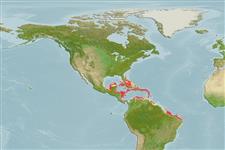Common names from other countries
>
Blenniiformes (Blennies) >
Chaenopsidae (Pike-, tube- and flagblennies)
Etymology: Lucayablennius: Composed from Lucaya = the old name for the Bahamas Islands + Greek, blennios = mucus (Ref. 45335).
Environment: milieu / climate zone / depth range / distribution range
Ecologia
marinhas associadas(os) a recifes; intervalo de profundidade 13 - 106 m (Ref. 9710). Tropical
Western Central Atlantic: Bahamas and Caribbean, including the Antilles.
Tamanho / Peso / Idade
Maturity: Lm ? range ? - ? cm
Max length : 5.0 cm SL macho/indeterminado; (Ref. 51458)
Espinhos dorsais (total) : 18 - 20; Raios dorsais (total) : 19 - 20; Espinhos anais: 2; Raios anais : 22 - 23. With emarginate caudal fin. Reddish tan, with 3 large dark spots along rear of dorsal fin base, and 2 similar spots along rear of anal fin base (Ref. 26938). Black stripe from tip of lower jaw through eye to end of operculum; a median dorsal light yellow line on head (Ref. 13442).
Inhabits coral reefs (Ref. 5521). Drifts with bended tail to prey on small fish. Retreats into holes or empty worm tubes. Ignores divers (Ref. 9710). Often seen with schools of masked gobies (Ref. 26938).
Ciclo de vida ou comportamento de acasalamento
Maturities | Reprodução | Spawnings | Egg(s) | Fecundities | Larvas
Böhlke, J.E. and C.C.G. Chaplin, 1993. Fishes of the Bahamas and adjacent tropical waters. 2nd edition. University of Texas Press, Austin. (Ref. 5521)
Status na Lista Vermelha da UICN (Ref. 130435)
Warning: mysqli::__construct(): (08004/1040): Too many connections in /var/www/html/includes/func_getlabel.php on line 46
Can't connect to MySQL database (fbapp). Errorcode: Too many connections
